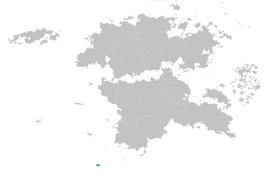Andria Protectorate
This article is incomplete because it is pending further input from participants, or it is a work-in-progress by one author. Please comment on this article's talk page to share your input, comments and questions. Note: To contribute to this article, you may need to seek help from the author(s) of this page. |
The Protectorate of Andria Il Protettorato di Andria | |
|---|---|
| Motto: "Watchful guardians of the south." | |
| Anthem: The Secrets of the Sea I Segreti del Mare (Instrumental) | |
 Location of the Protectorate in Tyran. | |
| Status | Military Protectorate |
| Capital and largest city | Andria |
| Official languages | English, Italian |
| Ethnic groups | 69.8% Cacertian 30.2% Nalayan |
| Demonym(s) | Andrian |
| Government | Cacertian Military Protectorate |
• Military Governor | Admiral Elsa Rivera |
| Cacertian Military Protectorate | |
• Discovery (claimed by the Lombardo Matriarchy) | 22 March 1425 |
• Incorporation (into the Unified States of Cacerta) | 6 June 1871 |
• Protectorate (under the Cacertian Empire) | 23 October 1880 |
| Area | |
• Total | 4,470 km2 (1,730 sq mi) |
| Population | |
• 2017 census | 104,895 |
The Andria Protectorate is a military protectorate of the Kingdom of Cacerta located southwest of the nation of Nalaya. It is the home of and serves as the staging base for the Royal Army’s 5th Amphibious Assault Division. It is also the primary staging base for the Royal Navy’s 5th Amphibious and 6th Battleship Strike Fleet as well as the Royal Air Fleet’s 3rd Expeditionary Aerial Battle Group.
The Island of Andria is the only region under the umbrella of Cacerta that is registered as a military protectorate. Due to the location of its strategic importance, the Protectorate is host to the largest Cacertian military installation outside of the Home Islands—second only to the combined arms base in Fumicino. The population of 104,895 consists mostly of migrant Cacertians—members of the Cacertian Armed Forces and their families—and Nalayans.
The territory is the only region within Cacerta that is not directly overseen by a monarchy and is instead ruled by an appointed military governor; the acting commanding officer of JOC, Andria. The governor possesses complete oversight over the Protectorate by rule of the Monarch but can be replaced whenever necessary. The current military governor of the Andria Protectorate is Admiral Elsa Rivera, a veteran of the FedCom Civil War and Nalayan Civil War, who assumed her position in March 2017.
History
Early History and Centuries War Period
House Davion explorers discovered the uninhabited island early in the 15th century and claimed it in the name of their matriarch-ruler Andria Davion on 22 March 1425 also naming it in her honor. There was very little about the island of Andria that made it a particularly enticing prospect other than it was the largest body of land in the Sabri Sea. In the hopes of extending House Davion influence westward, Andria sponsored the construction of a port town on the island’s eastern coast to serve as a staging base for later Davion explorers and warships. The initial town of Andria was completed in September 1425.
Throughout most of the Centuries War period, Andria Island played a very minimal role; mostly serving as a resupply way point for various trade ships and merchants. A number of Lombardi warships were stationed at the town to act as a small security force, however the popularity of the frequent travel of various vessels made it a popular pirating area. Ships stationed at Andria were able to successfully hunt down various privateers traveling the southern seas. This allowed House Davion to effectively close the southern passages to foreign pirates raiding cities in Cacerta and made the Lombardo Matriarchy a valuable ally to many.
Andria’s role in stymieing the ongoing slave trade exploited by Shalumite pirates and privateers during this time period resulted in the island being declared a neutral zone between the warring Cacertian factions. In this early period, the civilian population of Andria was made up of a large number of liberated men and women who had been freed following combat with slavers—many elected to stay and grow the city resulting in the creation of a large agricultural and shipbuilding market on the island.
The military significance of these naval interceptions conducted by forces from the island—in turn—made Andria a primary target for retaliating pirates and brigands attempting to wrest control from Davion naval forces. This later provided enough incentive to begin construction of a coastal fortress, a project undertaken by Andria’s successor, Eerika Davion-Waterly, in 1530. The bastion fort was constructed on high cliffs that overlooked the Andria Bay and provided an advantageous defensive position against most potential invaders.
The island remained a primarily anti-pirating and anti-slavery base for much of the remainder of the Centuries War Period and was one of only a handful of islands not ravaged by the civil wars. As a result, alongside Cesena and Fumicino, the city of Andria possesses some of the oldest and best preserved structures from the period.

